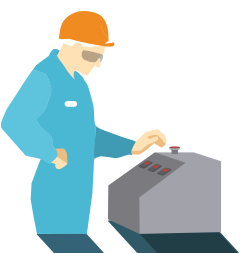General Interaction Design Principles – Conformity with User Expectations
Designing the interaction interface is to be done appropriate for the tasks. Human task performance capabilities and limitations (e.g., vision, language, memory, size of fingers) define the design requirements for interaction interface design. The design of human-system interaction interfaces according to requirements facilitates operator interactions to perform assigned tasks safely and efficiently.
Among the interaction interface design requirements, the indicated requirement is presented in detailed below.
- Suitability for the Task
- Self-Descriptiveness
- Controllability
- Conformity with User Expectations
- Error Tolerance
- Suitability for Individualisation
- Suitability for Learning
Among the interaction interface design requirements "Conformity with User Expectations" is important to allow the operator to perform his/her task.
Adapt interface design to culture and stereotypes of the country of machinery use. In Europe, for example, right turn of dial increases volume and right turn of tap increases closure of water flow. Reading is from left to right. Other countries may have different stereotypes.
Interactions conform to user expectations if they correspond to predictable contextual needs of the user and to commonly accepted conventions.
The Figure indicates same measures on distillation temperature displays, however, level increase to right conforms expectations in some but not all countries.
Population stereotype examples linked to user expectations are listed as follows:
- Handles used for controlling liquids are expected to turn clockwise for off and anti-clockwise for on
- Knobs on electrical equipment are expected to turn clockwise for on, to increase current, and anti-clockwise for off or decrease in current.
- Certain colours are associated with traffic, operation of mobile or stationary machines, and safety.
- For control of mobile machines in which the operator is in control, the operator expects a control motion to the right or clockwise to result in a similar motion of the machine, and vice versa.
- Sky-earth impressions carry over into colours and shadings: Light shades and bluish colours are related to the sky or up, whereas dark shades and greenish or brownish colours are related to the ground or down.
- Things which are further away are expected to look smaller.
- Coolness is associated with blue and blue-green colours, warmness with yellows and reds.
- Very loud sounds or sounds repeated in rapid succession, and visual displays which move rapidly or are very bright, imply urgency and excitement.
- Very large objects or dark objects imply heaviness. Small objects or light-coloured ones appear light in weight. Large, heavy objects are expected to be at the bottom. Small, light objects are expected to be at the top.
- People expect normal speech sounds to be in front of them and at approximately head height.
- Seat heights are expected to be at a certain level when a person sits down.
References
- EN 894-1 (2010). Safety of machinery – Ergonomics requirements for the design of displays and control actuators – Part 1: General principles for human interactions with displays and control actuators. Brussels: CEN.
- Kantowitz, B.H., Sorkin, R.D. (1983). Human factors: Understanding people-system relationships. New York: Wiley.
- Nickel, P., Bärenz, P., Bischoff, H.-J., Monica, L., Kaufmann, U., Wichtl, M., Poddar, E., Radandt, S. (2021). Work System Design in Machine and System Safety with a Focus on Human-System Interaction. Lecture Notes in Networks and Systems (LNNS) 222, vol. 4, 154-160. [https://doi.org/10.1007/978-3-030-74611-7_21]
- Wickens, C.D., Hollands, J.G., Banbury, S., Parasuraman, R. (2013). Engineering Psychology and Human Performance. Upper Saddle River: Pearson.
- Woodson, W.E. & Conover, D.W. (1973). Human engineering guide for equipment designers. Berkeley: University of California Press.


